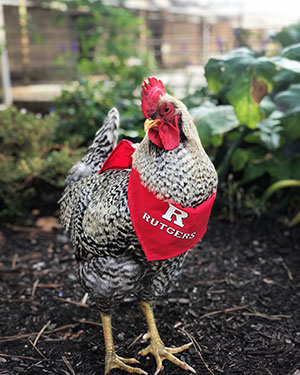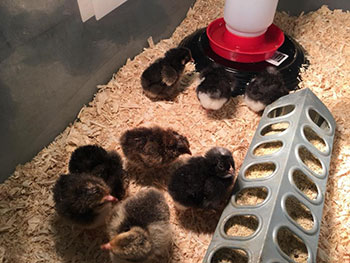Fact Sheet FS148

Rutgers Farm Mascot
This fact sheet updates the original publication FS148 by John Bezpa, former Extension Specialist in Poultry Science and highlights some of the important points or questions often asked regarding management of a small flock of chickens for egg production.
Establishing a plan for any type of business venture is always a good idea. Livestock production—small or large scale—is no exception. What is your goal? Do you want to produce fresh eggs, meat, or raise pets? Do you want to teach your children the responsibility of caring for animals? Do you want to show birds as part of a 4‑H or other youth program? Or do you want the enjoyment of watching and caring for poultry?
Check with local, county, state, and even federal zoning and environmental regulations as some townships may prohibit poultry flocks in your area. Zoning regulations are usually specific about the number of animals and environmental considerations, such as flies, odor, and noise. Check with your county Cooperative Extension office or representatives of government agencies for information before planning a flock. Also, consider the proximity to your neighbors and their opinions. Good neighbor relations are very important, and the town may have specific regulations for structures or fencing needed for your flock.
Home flocks, no matter what the size, require water, food, and daily care. This will include weekends, any planned vacations you have, and of course, holidays. The time and effort required for this care should be considered in weighing your desire for a home flock against other possible uses of your time and labor. Caring for a flock is a 24-hour, seven day a week commitment that begins with your very first bird.

Poultry chicks
Why a Small Flock?
Raising a small flock of chickens can serve several basic purposes:
Type of Bird
There are many types of poultry:
Egg Laying Breeds
Chickens raised solely for egg production. White Leghorn produces a white eggshell, is the most economical converter of feed into eggs [av. 3.5 lb. of feed/dozen eggs or 3.5:1], but is generally more skittish than the brown egg varieties.
Broilers & Fryers Breeds
Chickens raised solely for meat. Common broiler breeds are Cornish and Plymouth Rock Crosses. They are broad-breasted and larger than layer breeds. They are typically harvested at 3.5–5.0 pounds.
Dual Purpose Breeds
Chickens raised for both meat and egg production. The sex link variety (crossbred chickens whose color at hatching is differentiated by sex, thus making chick sexing an easier process) rather than the pure strains (Barred Rock, New Hampshire Red, Holland (created at Rutgers), etc.) are preferred for a small family flock and, in general, best meet the needs for egg and meat production. These breeds are typically docile.
Flock Size
Flock size varies with individual family needs. A good commercial breed, with sound management, nutrition, and sanitation can produce 240 to 280+ eggs/birds during the first 12-month cycle. Birds kept for a second laying cycle produce approximately 20% fewer eggs. In determining the number of birds to meet family egg needs, consider these factors:
Housing and Basic Management Requirements
There are different ways to house poultry: coop, hoop pen, chicken tractor, depending on your method of production and available space in your yard or property. Regardless of method, housing is required to protect your flock from weather conditions and predators.
| Type of Bird | Sq Ft/Bird Inside | Sq Ft/Bird Outside Runs |
|---|---|---|
| Bantam Chickens | 1 | 4 |
| Laying Hens | 1.5 | 8 |
| Large Chickens | 2 | 10 |
| Quail | 1 | 4 |
| Pheasant | 5 | 25 |
| Ducks | 3 | 15 |
| Geese | 6 | 18 |
*Please remember that these numbers are suggestions. All situations are somewhat different and may require township approval.
Feed and Water
Nutritionists have taken out the guesswork for feeding poultry. Complete diets have been manufactured for poultry at all stages of life. Chicks from 0–6 weeks old should be fed a “starter” ration. Pullets (adolescence) from 6–20 weeks should be fed a grower ration. Laying hens should be fed a layer diet. Clean water should always be available and easily accessible to the flock. Most of these feed mixes are available at local feed or farm supply stores. If you are using a chicken trailer, then some of the birds’ requirements will be met as they feed on your lawn or turf area or pasture. Pasture-based birds should still receive supplemental nutrition with the appropriate “stage of life” feed.
| Feed | Protein Level (%) | Age of Birds | Feed Intake/10 Birds/Age Period |
|---|---|---|---|
| Chick starter | 20–22 | 0–6 weeks | 20–29 lb. |
| Pullet grower | 14–16 | 6–20 weeks | 120–130 lb. |
| Layer | 15–18 | 20 weeks on | 18–24 lb./week |
Water is essential for flock success and must be available to the flock at all times. The first sign that water intake is inadequate is when birds stop eating.
Lights for Maximum Production
Laying birds should never be exposed to a decreasing light period if the goal of your flock is maximum egg production. Provide 14–16 hours of light per day. Natural light reaches its peak on June 21 and decreases until the shortest day on December 21. Use artificial light to provide a constant light source to supplement the loss of natural light. An inexpensive time clock may be installed to accomplish the desired lighting period. Be mindful of your neighbors with added noise or light during the winter months.
Disease Control and Sanitation
Vaccines are available for certain troublesome poultry diseases such as Newcastle, Bronchitis, and Fowl Pox. Vaccines are usually available at your local feed dealer—not to be confused with veterinary feed directives. Check with your veterinarian, chick supplier, state diagnostic lab, extension poultry specialist, county agricultural agent, or feed supplier for recommendations in your area. Good sanitary and biosecurity practices should be established and maintained throughout the life of the bird. This means daily cleaning of the drinking pans, spraying for lice and mites when needed, and good housekeeping measures (manure removal, etc.) are needed to keep a flock healthy. Details regarding disease, sanitation, and other management recommendations are generally available at your local feed supplier, health department, or county cooperative extension office. Your local extension office can also give you information about meeting the New Jersey animal waste management guidelines. Many producers are required to file a formal plan, though most small backyard flocks will not need to (see information on Animal Waste Management).
Culling
Unless kept for reasons other than eggs, birds that stop laying eggs during the first 4-5 months of their production cycle should be removed from the flock. Such a practice will also reduce feed costs. If cull birds are otherwise healthy, they can be slaughtered for home consumption.
Egg Handling
Eggs should be gathered at least twice a day. This is very important during summer months, as exposing eggs to high summer temperatures will rapidly decrease their quality and increase disease risk. Keep gathered eggs in a refrigerator at or below 45 degrees Fahrenheit. Under good holding conditions, eggs can maintain a high level of quality for 2 to 3 weeks and longer.
Additional Information and References
- Common Poultry Diseases. University of Florida IFAS Extension. 2018.
- How Much Will My Chicken Eat? (PDF). University of Kentucky Cooperative Extension. 2012.
- Processing Chickens (PDF). University of Kentucky Cooperative Extension. 2013.
- Selecting the Right Chicken Breed (PDF). University of Kentucky Cooperative Extension. 2012
- Small Scale Poultry Housing. Virginia Tech Cooperative Extension. 2009.
- So You Want to Produce Your Own Eggs? (PDF). University of Kentucky Cooperative Extension. 2014.
- American Poultry Association
April 2020
Copyright © 2024 Rutgers, The State University of New Jersey. All rights reserved.
For more information: njaes.rutgers.edu.
Cooperating Agencies: Rutgers, The State University of New Jersey, U.S. Department of Agriculture, and Boards of County Commissioners. Rutgers Cooperative Extension, a unit of the Rutgers New Jersey Agricultural Experiment Station, is an equal opportunity program provider and employer.

